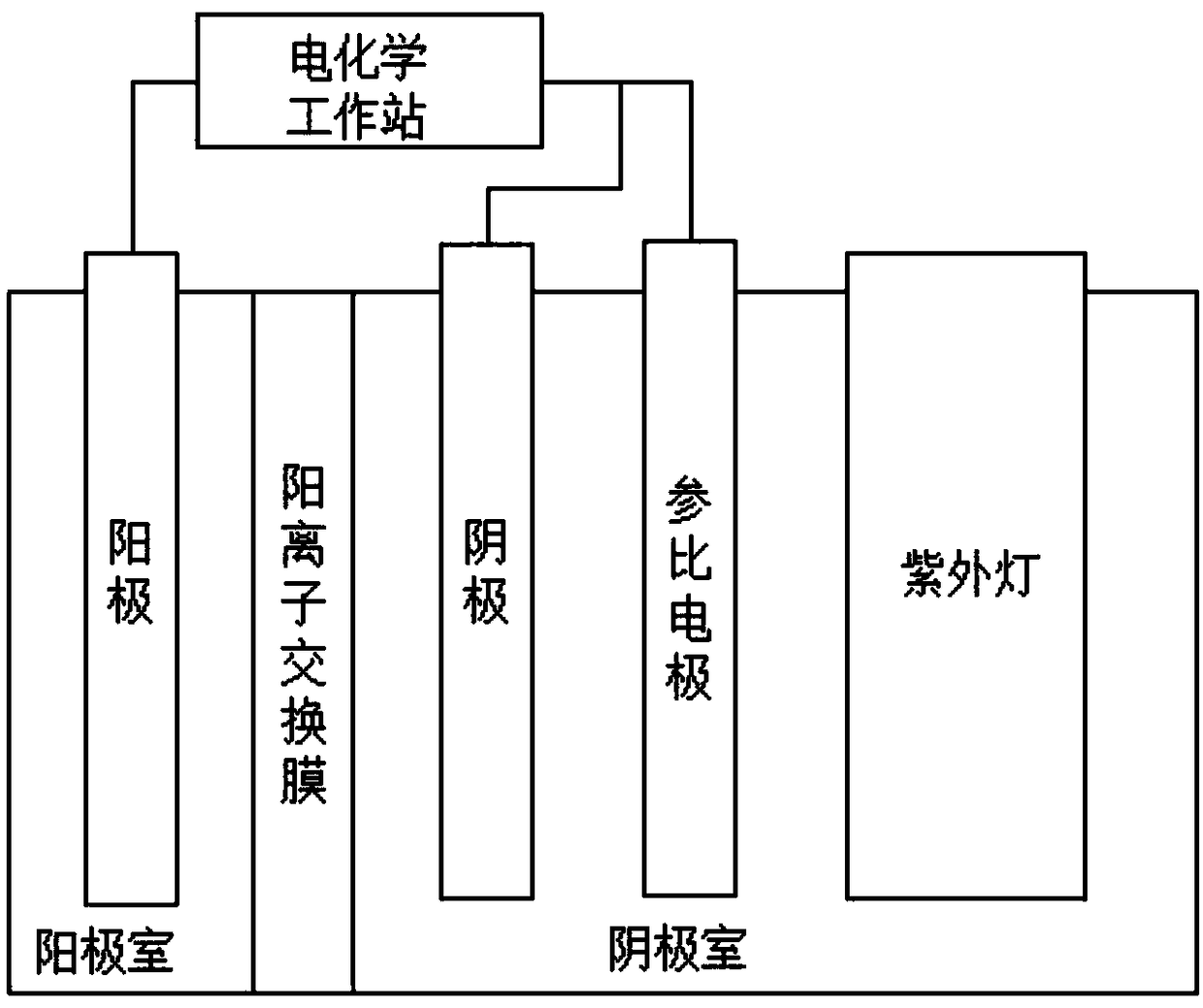Method for recycling elemental antimony in pentavalent antimony wastewater through photoelectric coupling
A photoelectric coupling and pentavalent antimony technology, applied in the field of water treatment, can solve the problems of low antimony recovery rate and low pentavalent antimony removal rate, achieve high reduction efficiency, small secondary pollution, and improve removal efficiency
- Summary
- Abstract
- Description
- Claims
- Application Information
AI Technical Summary
Problems solved by technology
Method used
Image
Examples
Embodiment 1
[0030] In order to further improve the recovery of antimony, in this embodiment, the pentavalent antimony in the water body is recovered through an electrolytic system provided with a diaphragm. see figure 1 , which is a schematic structural diagram of a dual-chamber reactor in an embodiment of the present invention. The separation membrane between the cathode chamber and the anode chamber is a cation exchange membrane (CMI-7000), and the anode used is a ruthenium iridium electrode (with an area of 50×50mm 2 ), the cathode is a titanium sheet (the area is 50×50mm 2 ), the ultraviolet lamp adopted is an ultraviolet lamp with a rated power of 9W and a central wavelength of 254nm.
[0031] Specifically, the method includes the following steps:
[0032] 1) Using sodium tetraborate buffer as electrolyte, add 200mL sodium tetraborate buffer (10mM) to the anode chamber, add 140mL solution containing 50mg / L Sb(V) and 10mM sodium tetraborate to the cathode chamber; it should be po...
Embodiment 2
[0045] In order to further improve the recovery of antimony, in this embodiment, the pentavalent antimony in the water body is recovered through an electrolytic system provided with a diaphragm. see figure 1 , which is a schematic structural diagram of a dual-chamber reactor in an embodiment of the present invention. The separation membrane between the cathode chamber and the anode chamber is a cation exchange membrane (CMI-7000), and the anode used is a ruthenium iridium electrode (with an area of 50×50mm 2 ), the cathode is a titanium sheet (the area is 50×50mm 2 ), the ultraviolet lamp adopted is an ultraviolet lamp with a rated power of 9W and a central wavelength of 225nm.
[0046] Specifically, the method includes the following steps:
[0047] 1) Using sodium tetraborate buffer as electrolyte, add 200mL sodium tetraborate buffer (8mM) to the anode chamber, add 140mL solution containing 50mg / L Sb(V) and 8mM sodium tetraborate to the cathode chamber; it should be poin...
Embodiment 3
[0054] In order to further improve the recovery of antimony, in this embodiment, the pentavalent antimony in the water body is recovered through an electrolytic system provided with a diaphragm. see figure 1 , which is a schematic structural diagram of a dual-chamber reactor in an embodiment of the present invention. The separation membrane between the cathode chamber and the anode chamber is a cation exchange membrane (CMI-7000), and the anode used is a ruthenium iridium electrode (with an area of 50×50mm 2 ), the cathode is a titanium sheet (the area is 50×50mm 2 ), the ultraviolet lamp adopted is an ultraviolet lamp with a rated power of 9W and a central wavelength of 280nm.
[0055] Specifically, the method includes the following steps:
[0056] 1) Using sodium tetraborate buffer as electrolyte, add 200mL sodium tetraborate buffer (12mM) to the anode chamber, add 140mL solution containing 50mg / L Sb(V) and 12mM sodium tetraborate to the cathode chamber; it should be po...
PUM
 Login to View More
Login to View More Abstract
Description
Claims
Application Information
 Login to View More
Login to View More - R&D
- Intellectual Property
- Life Sciences
- Materials
- Tech Scout
- Unparalleled Data Quality
- Higher Quality Content
- 60% Fewer Hallucinations
Browse by: Latest US Patents, China's latest patents, Technical Efficacy Thesaurus, Application Domain, Technology Topic, Popular Technical Reports.
© 2025 PatSnap. All rights reserved.Legal|Privacy policy|Modern Slavery Act Transparency Statement|Sitemap|About US| Contact US: help@patsnap.com

